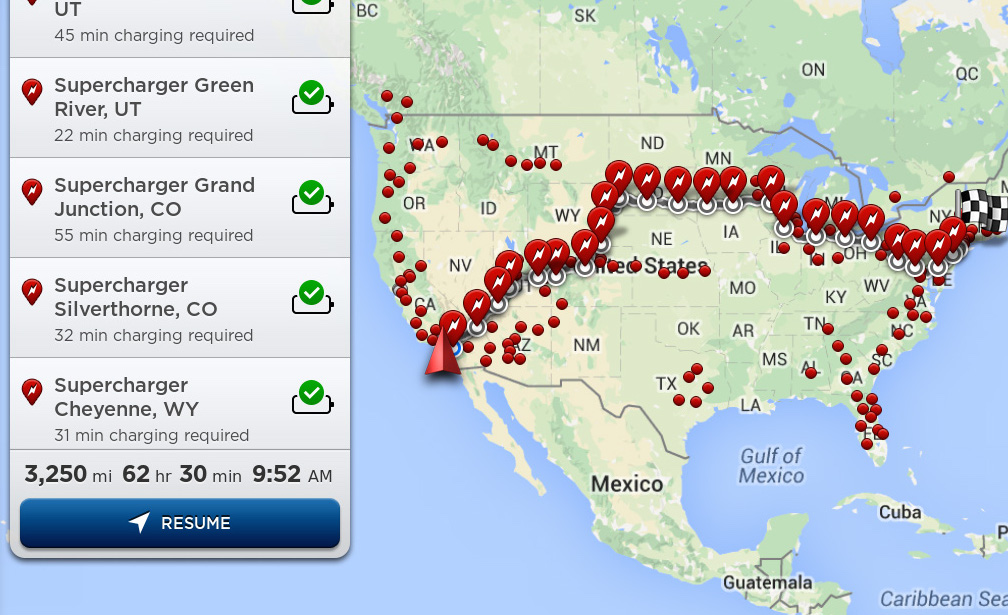

We've laid out some of the environmental and psychological factors involved in using an EV to cover longer distances. "If someone else is using it, you end up having to wait for an hour or so." "Having a single Level 3 machine at a location doesn't make sense," she said. In order to better serve a growing EV market, the infrastructure needs to improve, said Clairman, particularly in terms of offering more than one fast-charger at any given location. The woman on the other line told my wife that she could get someone out to look at the machine in about a week or so.Ĭara Clairman, CEO of Plug 'n Drive, a non-profit advocacy group for electric vehicles, said because a lot of companies are merely hosting these charging stations, they don't actually know how they operate. Instead, we called the help number on the machine. Having learned from our last experience, we didn't bother inquiring inside the station.
#ELECTRIC CAR ROAD TRIP PLANNER SOFTWARE#
The second time, we sidled up to a machine only to find it was having what looked like a software meltdown.

(We eventually got the machine to work don't ask me how.) When I asked a clerk inside the station for guidance, she didn't have the first clue, telling me dismissively that someone else had installed the machines, as though that was in any way a satisfying response. The first time, my wife and I stood dumbfounded in front of a Petro-Canada charging machine, unable to get either the app or a credit card to initiate the process.

It's a laudable idea, but my two experiences with "Canada's Electric Highway" were not reassuring. And now, you can do it in an electric vehicle." To that end, Petro-Canada has installed charging stations at a number of locations along the Trans-Canada Highway. And part of the problem is the disconnect between what's promised and what's operational.įor several years now, Petro-Canada has been touting its own charging network with the slogan, "You've always been able to drive from the Rockies to the Maritimes. But beyond that, our journey was incident-free.īut it isn't always this way. Of course, you have to find ways to amuse yourself for the 45 minutes to an hour that it takes to charge on a Level 3 machine. (Side note: Concerns have been raised that fast-charging your car too often weakens the battery, but the evidence is largely inconclusive.) As usual, we relied on the FLO app to guide us to available Level 3 (or fast-charge) stations. We recently completed a trip from Toronto to Montreal (about 550 kilometres) and back. The car has a range of about 350 kilometres, although that will drop in cooler temperatures. I've been driving a Nissan Leaf since June 2019, and have undertaken a number of longish trips with my family. While we're seeing improvements in Canada's charging network (with more coming, courtesy of Canada's Emissions Reduction Plan), the current situation is hardly ideal. It comes down to a familiar refrain: it's not the vehicles, but the infrastructure. Obtaining clean energy is one thing, but the idea that you can easily cover long distances in an EV is perhaps optimistic. But a recent study by the International Council on Clean Transportation showed that if you factor in all aspects of the vehicle - from manufacture to maintenance to fuelling - even an EV charging on a so-called dirty grid still produces significantly fewer emissions over its lifetime than a gasoline-fuelled one. Power generation is more emissions-intensive in provinces like Nova Scotia (mostly coal) and Alberta (mostly coal and natural gas). If you're in a province with a low-emissions grid - such as Manitoba (about 97 per cent hydro), Newfoundland and Labrador (96 per cent hydro), Quebec (94 per cent hydro) or Ontario (largely nuclear and hydro) - you can feel confident that your driving is not producing much pollution.

To properly understand the latter, you need to consider where you live. But electric vehicles (EVs) are certainly a low-carbon option for seeing Canada, one we thought we'd explore this week.ĮVs have no tailpipe emissions, but there are emissions involved in the manufacture of the vehicles, and quite often in the generation of the electricity needed to charge them. In our (humble) defence, the article was mainly concerned with the greenness of rail travel. In response to the article, a number of people wrote in, echoing this sentiment from reader Reynold Reimer: "I am disappointed to see no mention of electric cars in the piece about the greenest way to travel across Canada." In our last issue, Emily Chung examined the greenest ways to travel across Canada, challenging the assumption that train travel is necessarily lighter on emissions than air travel in covering the distance of this vast country. Electric vehicles charging at a station in Peterborough, Ont.


 0 kommentar(er)
0 kommentar(er)
